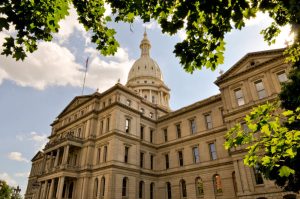
The following commentary was written by Laura Sherman, president of the Michigan Energy Innovation Business Council; and Samarth Medakkar, policy principal at Advanced Energy United. See our commentary guidelines for more information.
The shift to electric vehicles is firmly under way in Michigan. Across the Whitmer administration, the legislature, local and municipal governments and the private sector, a number of initiatives have been launched to make that transition happen. But the next year or so might be the most crucial time to determine the success of those efforts.
Through fiscal year 2026, the state of Michigan is receiving about $110 million in federal funding to realize the state’s plan to build an electric vehicle (EV) charger at least every 50 miles along several highway routes that the state has nominated for the federal government to designate as Alternative Fuel Corridors. These include some of the most well-known and well-traveled routes in the state, like Petoskey to the Mackinac Bridge and Detroit to the Blue Water Bridge. This $110 million comes from the National Electric Vehicle Infrastructure (NEVI) Formula Program, a U.S. Department of Transportation program created by the 2021 Infrastructure Investment and Jobs Act (IIJA).
At the same time, there is also $700 million that the federal government is expected to soon make available in grants through the five-year $2.5 billion Charging and Fueling Infrastructure Discretionary Grant Program, also established by the IIJA. These grants will help build publicly accessible EV chargers along urban and rural corridors. The state government is eligible to apply, but so are local governments, meaning that communities have an opportunity to propose projects that fit their unique needs.
But while these dollars come from the federal government, actually putting them to use is going to take hard work in Michigan.
Sign up for Energy News Weekly
Get the most important energy news of the week delivered directly to your inbox.
Crucially, the executive budget proposed by Gov. Whitmer includes a provision to allocate $45 million for a “Michigan Clean Fleet Initiative” to help counties, municipalities, airports, and regional transportation authorities switch their vehicle fleets to electric vehicles and clean fuels.
Through the MI Healthy Climate Plan, the governor has set a goal of 2 million EVs on Michigan roads by 2030. That would be a 100-times increase from 2021 levels of EV registrations in the state, and so the Clean Fleet Initiative investment must be accompanied by other steps to reach this goal.Those steps include building more charging infrastructure, and the executive budget sets aside $65 million in federal funds for deployment of chargersfor homes, apartment buildings and businesses.
But the barriers are also psychological, not just material. Consumers and businesses need to become more familiar with EVs. One of the biggest remaining barriers limiting the growth of EVs is the fact that “U.S. dealers and consumers continue to lack understanding of EV fuel and maintenance cost savings during [the] sales process,” according to the Brattle Group.
But several provisions in the budget will make these cost savings more apparent to consumers. For example, electric school buses have been among the most visible types of EVs. As of last September, Michigan had 19 electric school buses, according to the World Resources Institute. Compared to that starting point, the governor’s budget would be absolutely transformative: it includes $150 million to help school districts across the state purchase around 500 electric school buses.
These buses can provide their communities with an important lesson about the economics of vehicle electrification. Replacing a diesel school bus with an electric one can save a school district around $230,000 per bus over a 14-year lifespan, the Michigan Office of Future Mobility and Electrification has estimated.
Finally, the budget also sets aside $10 million to begin the transition of the State of Michigan’s fleet to electric vehicles. The state has over 13,000 vehicles across its various departments, and switching these to electric would send a powerful message, backed by the purchasing power of the state government, that Michigan is committed to EVs, as the Institute for Energy Innovation found in a 2019 report. There are a huge amount of potential savings from electrifying state fleets—for example, a recent analysis from Advanced Energy United found that the state of Florida could save nearly $280 million by considering the total cost of vehicle ownership, rather than just the purchase price, when making vehicle procurement decisions in great part because of the long-term maintenance and fuel cost savings from EVs.
These elements of the governor’s budget add up to a strategy for moving Michigan further toward the electrification of mobility. They could not come at a better time.



